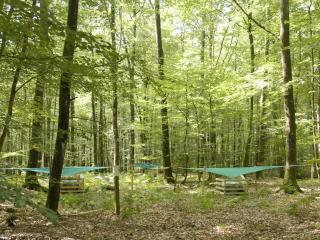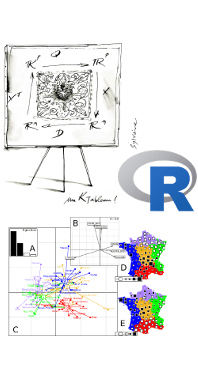Quantitative and Evolutionary Ecology of Communities Group
Members

Doctorante
UCBL

Professeure des universités
VetAgro-Sup
Tel: 33 04 72 43 27 56

Directeur de recherche
CNRS
Tel: 33 04 72 43 27 57

Doctorant
UCBL
Tel: 04 72 44 81 42

Doctorant
CNRS
Tel: 04 72 44 81 42
Doctorant
VetAgro-Sup

Maître de conférences
UCBL
Tel: 04 72 44 81 42


Professeur des universités
UCBL
Tel: 33 04 72 43 27 56

Professeur des universités
UCBL

Directeur de recherche
CNRS
Tel: 33 04 72 43 27 56

Maîtresse de conférences
UCBL
Tel: 33 04 72 43 29 02
Maître de conférences
UCBL
Tel: 33 04 72 43 29 02

Our research activities, focused on interspecific interactions (community ecology), aim to better understand the ecological and evolutionary processes structuring species assemblages and biodiversity at different temporal and spatial scales. Our team addresses these major issues using contrasting biological models (communities of large African mammals, insects, microbiota, plants) from 3 complementary angles:
- Our work is strongly anchored in the conceptual framework of evolutionary biology by studying (i) the diversity of adaptive responses implemented by organisms to selective pressures in their environment, (ii) their consequences on population demography and ultimately (iii) the dynamics and composition of species communities.
- Our research is closely linked to societal issues of biodiversity conservation and management by integrating both the functioning of socio-ecological systems and the context of climate change. We conduct experimental studies, manage and ensure the long-term monitoring of several community observation networks.
- Methodological issues also occupy a central place in our team, with the development of new tools for statistical processing and modeling of ecological data. This activity leads to the development of methods and software that we develop and distribute freely.
Research programs

Functioning of African savanna communities
The Hwange LTSER (Long-Term Socio-Ecological Research site in Zimbabwe hosts a long-term interdisciplinary research program that focuses on the functioning of plant and animal communities within the Hwange National Park and the interactions between this protected area and humans living in its periphery. Based on this program, three axes are developed: (1) studying the population dynamics of elephants, exploring their impact and that of management policies on the socio-ecosystem functioning; (2) Understanding the extent to which interactions within and between trophic levels are sensitive to management actions (e.g. sport hunting, water management) and climate change; (3) Decoding human ecology and human-wildlife coexistence mechanisms towards integrated conservation and sustainable functioning of the socio-ecosystem. This research is complemented by more recent works in the Hluhluwe-iMfolozi Park and in the Madikwe reserve in South Africa, which focus on the role of environmental conditions on the hunting success of large African carnivores. We work in close collaboration with the IRL (International Research Lab) Rehabs.
Involved group members : Alice Bernard, Laura Lacomme, Aïssa Morin, Lisa Nicvert, Elie Pedarros, Yolan Richard, Marion Valeix*

Masting and the community dynamics of seed consumers
Masting is a reproductive strategy often encountered in perennial plants, characterized by fructifications highly fluctuating in time and being synchronized at the population level. The seeds produced that way constitute a pulsed resource with a strong impact on the eco-evolutionary dynamics of seed-consuming communities and forest regeneration. Our lack of knowledge of this system still impedes our understanding of the dynamics of temperate forest ecosystems and its future in the context of climate change. Our work carried out on oak forests aims to better understand (i) the proximal causes of masting, (ii) the mechanisms underlying the coexistence of species competing for such highly fluctuating resource and (iii) the co-evolution of consumer exploitation strategies for the fluctuating resource and forest tree fruiting strategies. On the basis of the results obtained, scenarii will be proposed on the future of forest regeneration under climate change, that may serve forest management.
Involved group members : Marie-Claude Bel-Venner*, Emilie Fleurot, Léa Keurinck, Jean Lobry, Samuel Venner

The spread of antibiotic resistance genes in bacteria
Antibiotic resistance is recognized as one of the greatest current threats to human health, and the mobile genetic elements (MGEs) that circulate in bacterial populations and communities are the main vehicles. To understand the dynamics and diversity of MGEs in bacterial pangenomes and the emergence of antibiotic resistance genes, we propose to go beyond the framework of conventional genomics by considering pangenomes as complex ecological communities. In the Ab-One program, we mobilize the concepts and tools developed in community ecology based on an integrative approach (monitoring of bacterial populations/communities evolving in contrasting environments -One-Health approaches-, pan-genomic analyses, experimentation in molecular and cellular microbiology, mathematical modelling). This program is currently focused on the dynamics of MGEs in Acinetobacter baumannii, an antibiotic-resistant microorganism classified as a priority by the WHO. Other more general approaches will illustrate the relevance of this new conceptual framework to understand the dynamics and diversity of MGEs in bacterial pangenomes. This program, co-piloted by our team and a team from CIRI (Horigene) involves the participation of 9 organizations (6 from Lyon -LBBE, CIRI, MMSB, HCL, LEM, VetAgro Sup-, Institut Pasteur (Paris), LMGM (Toulouse ), Robert Koch Institute (Germany)).
Involved group members : Stéphane Dray, Rémi Tuffet, Samuel Venner*

Statistical analysis of ecological data
Understanding the structure and dynamics of species assemblages, and the processes behind them, requires collecting data that are becoming increasingly complex owing to the sophisticated technological developments made available for their acquisition (e.g. GPS, loggers, satellite imagery, molecular data). We are developing new methods for analysing such data, that provide new insights into the ecological processes at work in communities. Multivariate analysis methods allow the analysis of spatial structures, accounting for various information on species (functional traits, morphology, phylogeny), the spatio-temporal variation of species-environment relationships or the multifaceted perception of the protected human-environment relationship. We also model multi-'omics' dose-response data within communities in order to better understand the Adverse Outcome Pathway (AOP) and to better appreciate the risks to the environment. These methodological innovations are made available to the scientific community through the development, distribution and maintenance of software (libraries for the R language: ade4, adegraphics, adephylo, ade4TkGUI, nlstools, fitdistrplus, DRomics, seqinr).
Involved group members: Marie Laure Delignette-Muller, Stéphane Dray*, Jean Lobry, Jean Thioulouse.
Publications
Display of 511 to 540 publications on 656 in total
Use of Bayesian modelling in risk assessment: Application to growth of Listeria monocytogenes and food flora in cold-smoked salmon
International Journal of Food Microbiology . 106 : 195-208
Journal article
see the publicationSerotyping of Toxoplasma gondii in chronically infected pregnant women : predominance of type II in Europe and types I and III in Colombia (South America)
Microbes and Infection . 8 : 2333-2340
Journal article
see the publicationSynonymous codon usage and its potential link with optimal growth temperature in prokaryotes.
Gene . 385 : 128-136
Journal article
see the publicationNo Evidence for Tissue-Specific Adaptation of Synonymous Codon Usage in Humans
Molecular Biology and Evolution . 23 : 523-529
Journal article
see the publicationRevisiting the directionnal mutation pressure theory : The analysis of a particular genomic structure in Leishmania major
Gene . 385 : 28-40
Journal article
see the publicationMate-guarding strategies and male competitive ability. Results from a field study in an orb-weaving spider.
Animal Behaviour . 71 : 1315-1323
Journal article
see the publicationResource partitioning in a grazer guild feeding on a multilayer diatom mat
Journal of the North American Benthological Society . 25 : 800-810
Journal article
see the publicationSpatial modelling : a comprehensive framework for principal coordinate analysis of neighbour matrices (PCNM)
Ecological Modelling . -- : 483-493
Journal article
see the publicationLavandula species as accompanying plants in Cupressus replanting strategies : Effect on plant growth mycorrhizal soil infectivity and soil microbial catabolic diversity
Applied Soil Ecology . -- : 190-199
Journal article
see the publicationIdentification of Genomic Species in Agrobacterium Biovar 1 by AFLP Genomic Markers
Applied and Environmental Microbiology . 72 ( 11 ) : 7123-7131
DOI: 10.1128/AEM.00018-06
Journal article
see the publicationFluorescent pseudomonads occuring in Macrotermes subhyalinus mound structures decrease Cd toxicity and improve its accumulation in sorghum plants
Science of the Total Environment . 370 : 391-400
Journal article
see the publicationSerological and molecular ecology of Listeria monocytogenes isolates collected from 13 French pork meat salting–curing plants and their products
International Journal of Food Microbiology . 112 ( 2 ) : 153-161
Journal article
see the publicationPotential of a 16S rRNA-Based Taxonomic Microarray for Analyzing the Rhizosphere Effects of Maize on Agrobacterium spp. and Bacterial Communities
Applied and Environmental Microbiology . 72 ( 6 ) : 4302-4312
DOI: 10.1128/AEM.02686-05
Journal article
see the publicationLavendula species as accompanying plants in Cupressus replanting strategies: Effect on plant growth, mycorrhizal soil infectivity and soil microbial catabolic diversity
Applied Soil Ecology . 34 ( 2-3 ) : 190-199
Journal article
see the publicationRelationships between plant-parasitic nematode community fallow duration and soil factors in the Sudano-Sahelian area of Senegal
Agriculture, Ecosystems & Environment . 108 : 302-317
Journal article
see the publicationThe mycorrhizal fungus Glomus intraradices and rock phosphate amendment influence plant growth and microbial activity in the rhizosphere of Acacia holosericea
Soil Biology and Biochemistry . 37 : 1460-1468
Journal article
see the publicationSoil bacterial diversity responses to root colonization by an ectomycorrhizal fungus are not root-growth dependent
Microbial ecology . 50 : 350-359
Journal article
see the publicationSpider webs designed for rare but life-saving catches
Proceedings of the Royal Society B: Biological Sciences . 272 : 1587-1592
Journal article
see the publicationFate of Listeria monocytogenes in experimentally contaminated French sausages
International Journal of Food Microbiology . 101 : 189-200
Journal article
see the publicationPrevalence of Listeria monocytogenes in 13 dried sausage processing plants and their products
International Journal of Food Microbiology . 102 : 85-94
Journal article
see the publicationModelling the effect of a temperature shift on the lag phase duration of Listeria monocytogenes
International Journal of Food Microbiology . 100 : 77-84
Journal article
see the publicationDe la prévalence aux valeurs prédictives: L`antibiogramme face à l`évolution de la résistance aux antibiotiques
Annales de Biologie Clinique . 63 : 493-502
Journal article
see the publicationOnline synonymous codon usage analyses with the ade4 and seqinR packages
Bioinformatics . 21 : 545-547
Journal article
see the publicationForcing reversibility in the no-strand-bias substitution model allows for the theoretical and practical identifiability of its 5 parameters from pairwise DNA sequence comparisons
Gene . 347 : 175-182
Journal article
see the publicationCoupling principal component analysis and GIS to map deer habitats
Wildlife Biology . 11 : 363-370
Journal article
see the publicationFunctional diversity of soil microbial community, rock phosphate dissolution and growth of Acacia seyal as influenced by grass-litter and soil-feeding termite nest structure amendments
Geoderma . 124 : 349-361
Journal article
see the publicationMADE4: an R package for multivariate analysis of gene expression data
Bioinformatics . 21 : 2789-2790
Journal article
see the publicationSimultaneous analysis of a sequence of paired ecological tables with the STATICO method
Ecology . 85 : 272-283
Journal article
see the publicationSimple table for estimating confidence interval of discrepancy frequencies in microbiological safety evaluation
Journal of Microbiological Methods . 56 : 137-139
Journal article
see the publicationLife history traits and genome structure: aerobiosis and G+C content in bacteria
Lecture Notes in Computer Science . 3039 : 679-686
Journal article
see the publication
You also, comment on this article